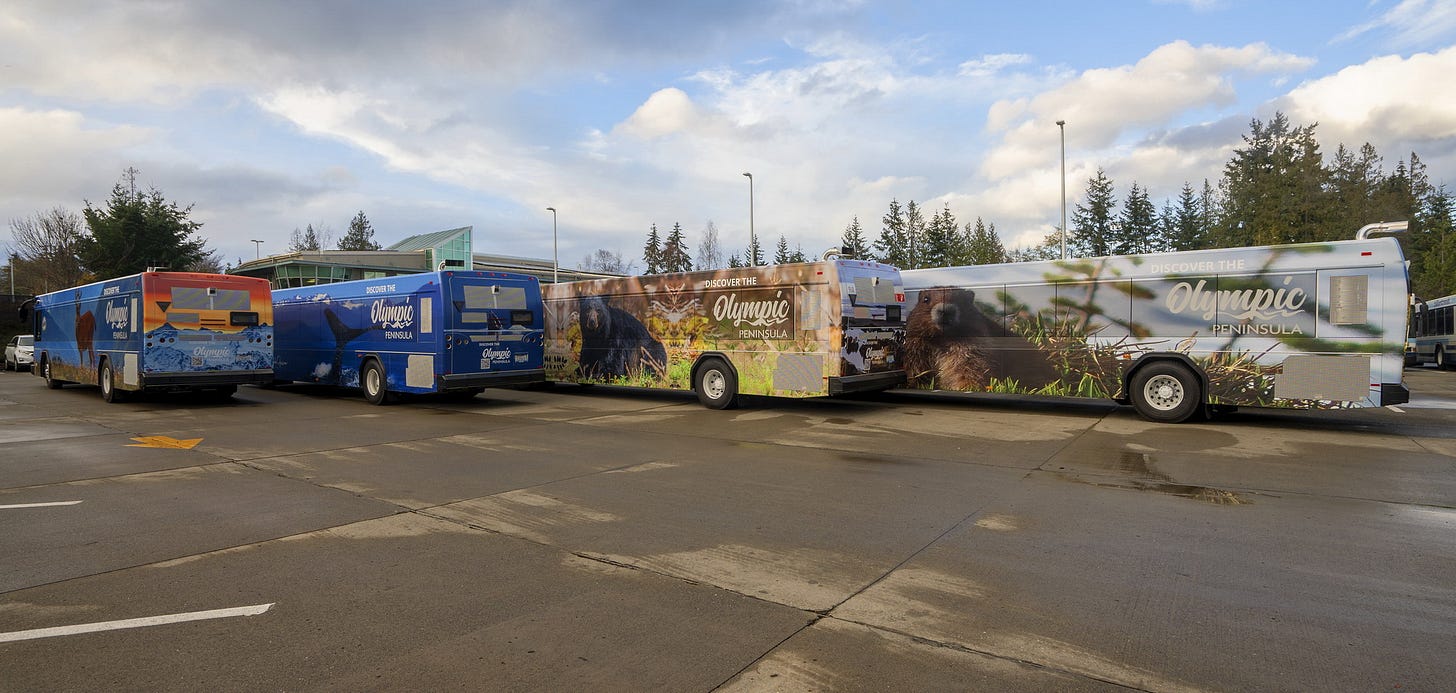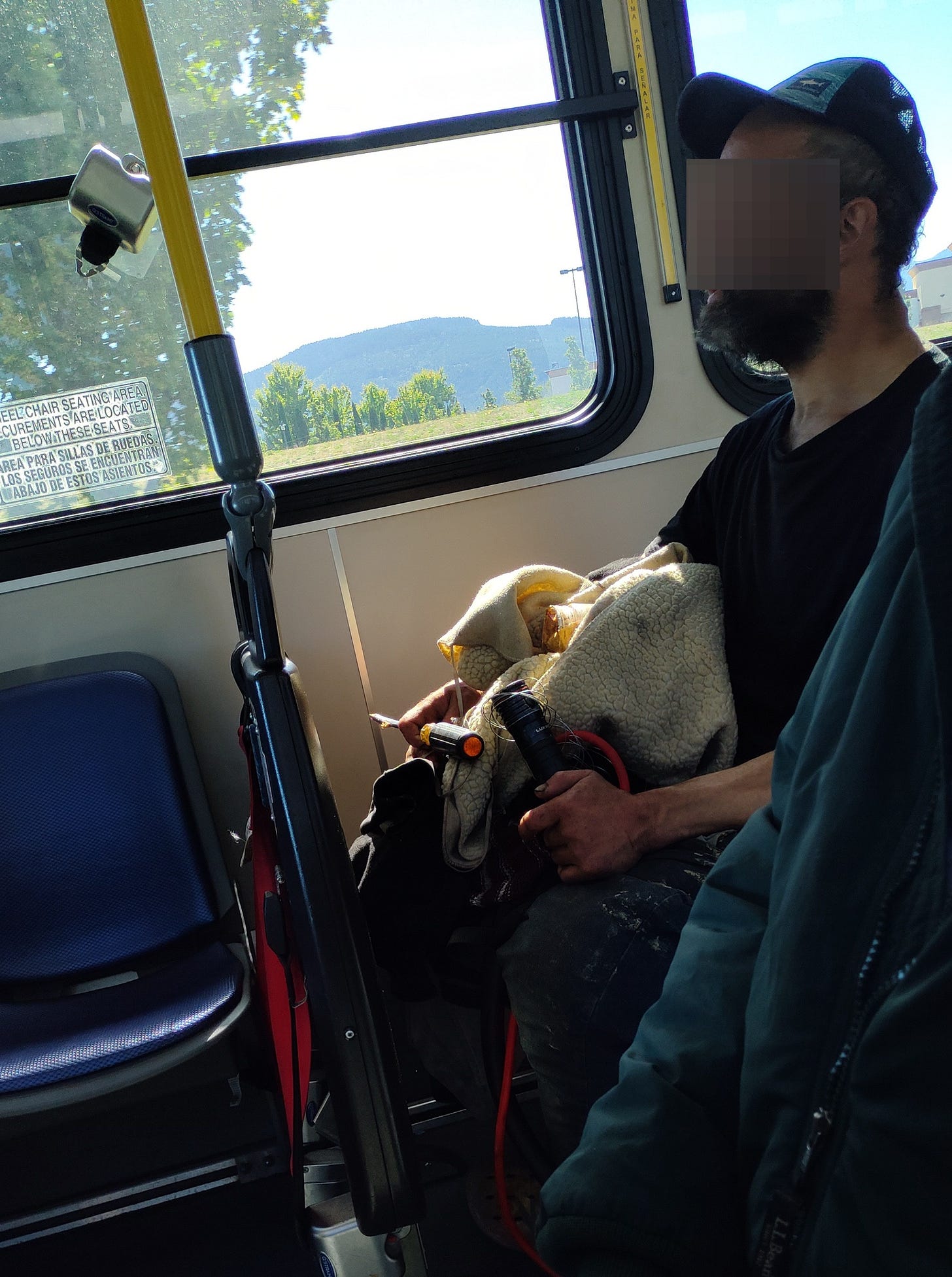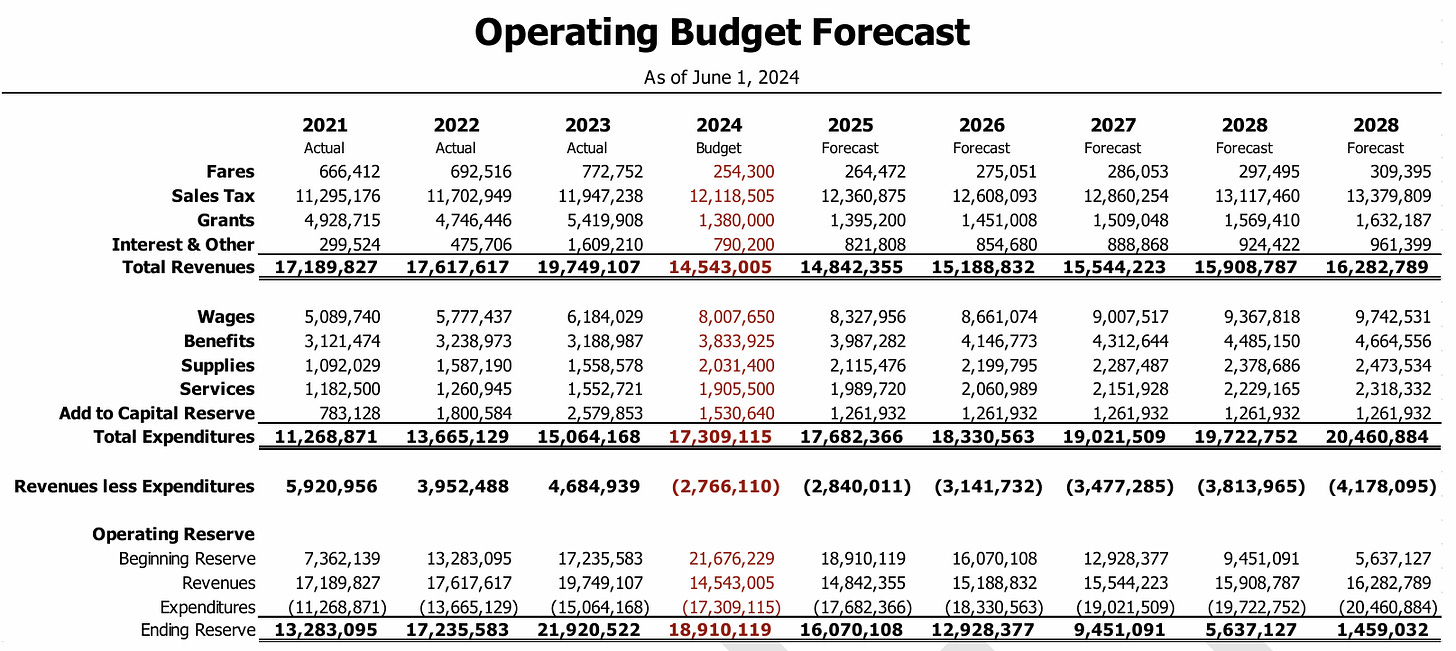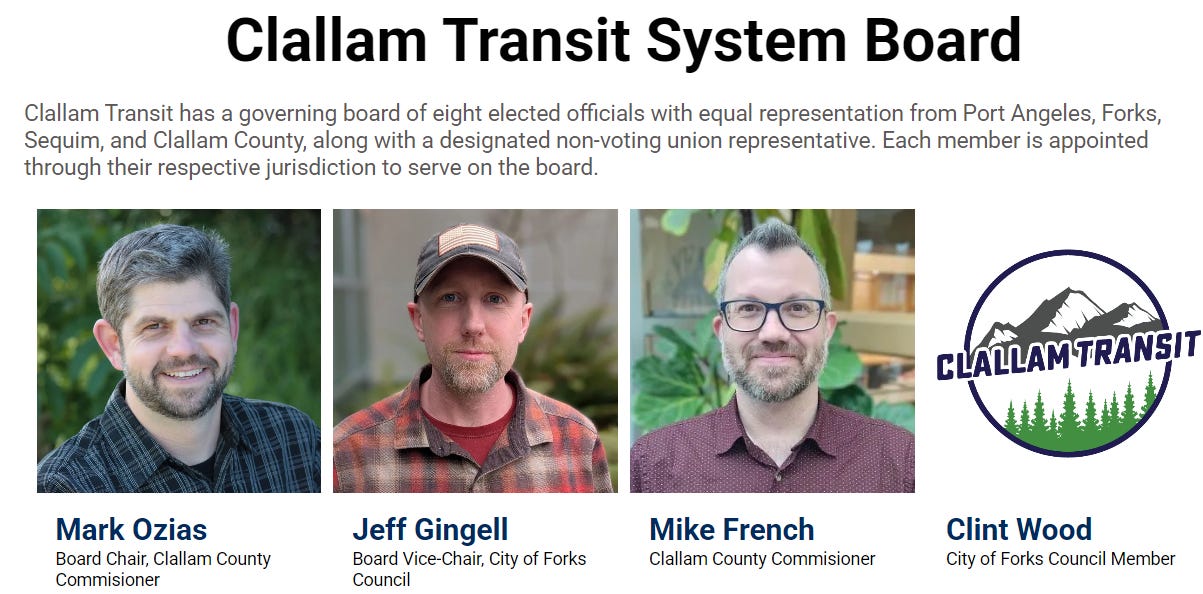County unveils new rolling homeless shelters
How to dismantle public transportation in just one year
Cherry-picked data shows Clallam Transit’s “success.” Another free service costing you $17 million a year. A twelve-month guide to turning a bus system into a train wreck. Why paint a bus when you can wrap it for three times the cost? How the Climate Commitment Act made me buy a truck.
Clallam Transit experienced its highest ridership ever in 2024 — over 800,000 boardings. “A real success for the agency,” reported Commissioner Mark Ozias at this week’s Board of Commissioners meeting. “I’m really happy about that.”
Last year’s fixed route ridership increased 36% from 2023. “I think that the zero-fare policy is certainly a significant driving factor,” concluded Ozias, who said that not paying bus fare has helped drive ridership recovery since Covid.
“The second factor that I would add,” said Commissioner Mike French, “is increased security. I think that Clallam Transit has invested in partnerships both with private security and with the City of Port Angeles to provide better security at the Gateway [Transit Center].”
French admitted that there have been a small number of security “exclusions” on Clallam Transit, mainly at the Gateway Center in Downtown Port Angeles and on the route between Port Angeles and Sequim. However, French said the new general manager wants to improve service and comfort by making buses a “cleaner, more respectful atmosphere.”
Is “zero-fare” free?
Riding Clallam Transit for free, a decision approved by the Transit Board in the fall of 2023, began on January 1, 2024.
The free fare program was made possible by the State’s Climate Commitment Act (CCA), a bill signed into law by then-Governor Inslee in May 2021. Essentially, the CCA is a hidden gas tax on every gallon of gas sold in the state, and it has contributed to Washington gas prices being the highest in the nation at times. On the Olympic Peninsula, where nearly everything arrives by truck, the CCA has increased the cost of goods and living.
Clallam Transit received $1.9 million for the free fare program in 2024. The Transit Board approved extending the program through 2025 with an additional $1.9 million from the CCA.
If you bought a gallon of gas last year, purchased packaged goods or groceries on the Peninsula, or ordered something from a retailer delivered by truck, you paid for riders to board Clallam Transit for free.
A 12-month review of the program
How is the free-fare program going?
The program began in January of last year. The PDN reported that fares traditionally brought the transit agency only $425,000, or 4% of its annual revenue, but about 80% came from a countywide sales tax. Advocates said not collecting fares would save staff time and expense since there would be no cash to count and no need for armored vehicles. Additionally, no individual tickets, monthly passes, or tokens would need to be sold or collected.
County Commissioner and Transit Board member Mike French said, “The buses are clean, and the staff is professional. It will help with how people perceive the system.”
In February last year, the PDN reported on the program’s success. Ridership was up 23% and, despite initial concerns from transit employees that free fares would attract people who wanted to ride the bus all day or engage in bad behavior, that hadn’t happened.
Four months into the program, last April, Clallam Transit’s Executive Director Jim Fetzer told the PDN, “As expected, we saw increases in all of our services.” Ridership was up 34% compared to the previous year. Fetzer disclosed, “We still have problems with customers once in a while, but a lot of those were interactions with paying fare, and those have gone away.”
By May of last year, things had changed at the Gateway Center in downtown Port Angeles. Fetzer told the PDN, “We had campfires in the mezzanine, we had people down there that were just completely out of their mind, feces, all kinds of things.”
The $15.4 million Gateway Transit Center opened in 2009 across from the Coho ferry dock. It’s often the first glimpse visitors see of Port Angeles when disembarking from Victoria.
The Clallam Transit System Board decided to consider installing a Narcan dispenser at the transit center, which would hold 30-40 doses of a drug to reverse fentanyl, heroin, and Oxycontin overdoses.
“It is no secret that the administration and employees do not want this,” Rick Burton, a union representative, told the Transit Board. “Your ‘no’ vote doesn’t mean Narcan won’t be available in Port Angeles or Clallam County; it just won’t be available at Gateway.”
A maintenance worker with 24 years of service told the Board that making Narcan available would negatively impact his department, which had been dealing with an increased amount of drug paraphernalia and needles at bus stops. The worker also reported that since the free-fare program had begun, there had been more frequent biohazard spills on buses.
Transit board member Port Angeles Mayor Kate Dexter argued that the high rate of overdose deaths in the county merited serious consideration for making Narcan readily available, and the Board decided to install a Narcan dispenser at the Gateway Center.
Three months later, in August, Fetzer told the PDN that the free-fare program continued to positively impact ridership. In fact, not asking riders to pay was credited with decreasing the number of fare disputes and it had reduced boarding times (however, more stops were being made, which slowed service).
Before the free fare program, the regular base fare had been $1 ($.50 for seniors or those with disabilities). The route between Port Angeles and Sequim had been $1.50 (or $1 for the reduced fare). “It seems like it [the free fare program] has removed an enormous barrier for a lot of people,” Operations Manager Jason McNickle told the PDN.
By September, the PDN reported that Fetzer was considering hiring private security for the Gateway Center. The Port Angeles Police Department’s downtown resource officer’s headquarters overlooks the transit center, but concerns regarding public safety, illegal activity, and public disturbances necessitated an additional presence.
In October, the PDN reported that a Clallam Transit supervisor had been attacked at the Gateway Center. Fetzer said there hadn’t been any real problems with the Narcan dispenser at the Port Angeles Gateway Center because the Harm Reduction Health Center had kept it stocked. The Transit Board also agreed to install a Narcan dispenser at the Sequim Transit Center.
In December, Clallam Transit entered a two-year private security contract for $154,000 ($76,000 for the first year, $78,000 for the second year). According to the PDN, the extra patrol provides public safety and security services at the Gateway Center. A rise in violent behavior, loitering, and vandalism had made the decision necessary.
Fare enough?
Without fares coming in, how is Clallam Transit spending money?
Clallam Transit bought four new low-emission diesel buses and is preparing to order five more. Each bus costs $605,000.
Four buses are now adorned with photos of wildlife. According to the PDN, each bus cost $12,000 to wrap with the images. This cost was offset by not having to paint each new bus, which cost $4,300.

Five Ford Transit vans, each costing $100,000, are being purchased for on-demand Interlink service. The agency also bought 10 additional Ford Transits for its paratransit service and plans to order five more.
The Board reached an employment agreement with the agency’s Executive Director, Jim Fetzer, for $157,301. Fetzer, who leads the public transportation agency that provides free rides, will receive a monthly vehicle reimbursement of $550.
According to the agency’s Transportation Development Plan, Clallam Transit had a budget of $17,309,115 last year. Notably, reserves are forecasted to decrease from $16 million to $1.4 million over the next four years. This is similar to Clallam County Commissioners’ uncontrolled spending, which has allowed reserves to dip so low that our County is on the brink of insolvency. The commissioners have cut jobs and public services while raising property taxes and increasing fees to correct this.
The last ride
I loved riding the bus.
Being a “one-car family” was perfect for us. It provided extra space in the garage, and we saved money by not having to pay for additional insurance or maintenance. Working from home, it was easy to share a single car.
As the situation with Towne Road developed in the fall of 2023, I started traveling to the courthouse in Port Angeles twice a week. It was a 25-minute bike ride from our house to the Sequim Transit Center, and the 8:15 a.m. departure got me to the courthouse for the 9:00 commissioner work sessions on Mondays. The 9:15 a.m. departure got me to the 10:00 meetings on Tuesdays.
Paying the $1.50 was still a deal compared to having a second car. I relaxed on the bus and often had a book on my lap, but I always preferred watching the scenery out the window.
It was nice to board the bus in January 2024 without paying, even though I knew I was paying in other ways. As the Towne Road debacle intensified, Dad became interested in attending meetings. We would get rides to the transit center in Sequim and enjoy the 35-minute bus trip to Port Angeles.
Things slowly began to change.
Last summer, someone boarded the bus with four large crab pots. The pots still had seaweed hanging off them, and it smelled like fish scraps were still in the bait boxes. Dad and I thought the driver would deny the passenger boarding, but nothing was said. Then, we thought the passenger would be asked to clear the aisle. He tried his best but still blocked the aisle.
Soon, it was common to have wagons and carts heaped with personal belongings blocking the aisle. The bus was often delayed as the wheelchair ramp was extended so riders could push their wheeled carriers onto the bus and park them in the wheelchair-designated areas.
Route #30, the service every half hour between Sequim and Port Angeles, is called the “commuter,” and people were commuting. They would leave their tents and RVs at the Deer Park rest area, board the bus with wagons, sleeping bags, and pets, and commute to popular panhandling locations in Port Angeles.
Ridership was growing, but not just with people. Service animals are allowed on Clallam Transit, and the most popular variety is the Pit Bull. These “service animals” bark and sometimes fight with other “service animals.”
Ridership grew steadily, and then, last fall, it exploded.
When it started raining and turned cold, the buses transformed into rolling homeless shelters. For 35 minutes, people could stay warm and dry between Port Angeles and Sequim. They disembarked for a few minutes and boarded the same bus for another 35-minute return trip.
While the buses wrapped in photos of wildlife were eye-catching, it made looking out the windows difficult. As the atmosphere changed inside the bus, I realized that I felt safer when people outside the bus could see through the windows to what was happening inside the bus. Psychologically, I began feeling trapped and helpless.
The last time Dad rode the bus, he had the aisle seat. A passenger sat across from him and took out a long screwdriver. The man was homeless and seemed to suffer from a mental condition aggravated by substance abuse. He began dipping the screwdriver’s tip into a jar of peanut butter, wiping it on a black flashlight, and licking it off. He did this the entire trip between Port Angeles and Sequim, dropping the jar, flashlight, and screwdriver several times. When he disembarked, peanut butter was on the floor, the seats, and the walls.

The last time I rode the bus was worse. I sat diagonally across the aisle from a mother with an infant in a stroller.
A man boarded the bus, looked at someone behind me, and yelled, “Don’t f**king look at me.” After sitting down, he told the passenger several more times not to look at him. The man behind me finally said, “Sir, I’m not looking at you.”
“You wouldn’t be looking at me like that if I had my gun,” he told the passenger, who was struggling to stay calm.
The young mother had pulled the stroller as close to herself as possible, and now she leaned over it. I was watching something that I thought only happened in war-torn countries and hostage situations: a mother was shielding her baby with her own body. The bus was nearly full but completely silent.
The driver, protected by a plexiglass divider, had been monitoring the situation, which was resolved when the angry passenger pulled the cord and disembarked after less than ten minutes. Once outside the bus, he angrily erupted, yelling through the door. He promised that next time would be different because he would have his gun. The bus pulled away.
I knew it was finally time to buy a second car.
Today, our garage has been reorganized, and my new truck, which the Climate Commitment Act forced me to buy, barely fits, but I don’t care — it allows me to feel safe and comfortable.
Hopefully, 2025 will bring positive change to the buses we fund. The agency is under new leadership; the Clallam Transit System Board has elected a new chair, Clallam County Commissioner Mark Ozias.
Poll
In last week’s article about commercial fish farming using net pens, subscribers were asked, “Which is more important?” Out of 223 votes cast:
53% said “protecting wild salmon habitat.”
34% said “sustainability of our food.”
9% said “saving the whales.”
2% said “Jamestown’s financial success.”
2% said “None of the above, I hate fish.”







Hurricane Ridge closed this entire weekend due to freezing sewer lines. The Hoh is closed due to road repairs, and so is the Elwha Ranger Station. Seeing a bus wrapped in a picture of a marmot might be the closest we get to seeing the National Parks we pay for.
A subscriber made an excellent observation on the Operating Budget Forecast located mid-article, and I've added a few sentences:
"According to the agency’s Transportation Development Plan, Clallam Transit had a budget of $17,309,115 last year. Notably, reserves are forecasted to decrease from $16 million to $1.4 million over the next four years. This is similar to Clallam County Commissioners’ uncontrolled spending, which has allowed reserves to dip so low that our County is on the brink of insolvency. The commissioners have cut jobs and public services while raising property taxes and increasing fees to correct this."